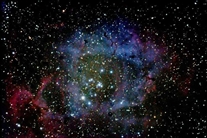ngc2244-rosette-neb_40deg_140mmf070_20d-nr_3x480SecISO1600_Avg_ip-ddp2473-astrotools-sat-crv_ninja.jpg
The Rosette Nebula - (NGC 2244) and NGC 2237-9,46, Diffuse Nebula NGC 2237-9,46, Open Cluster NGC 2244 (= H VII.2), type 'c', in Monoceros
Rosette Nebula taken with TEC140mm f/7.0, canon 20d with in-camera noise reduction. 3x8mins at 1600 iso from backyard in bay area. Stacked with Images Plus 2.83, then processed in PhotoShop with astrotools, color saturation, curves, and Noise Ninja.
The Rosette Nebula - (NGC 2244) and NGC 2237-9,46, Diffuse Nebula NGC 2237-9,46, Open Cluster NGC 2244 (= H VII.2), type 'c', in Monoceros
Right Ascension 06 : 32.3 (h:m) 06 : 32.4 (h:m)
Declination +5 : 03 (deg:m) +4 : 52 (deg:m)
Distance 5.5 (kly) 5.5 (kly)
Visual Brightness ? (mag) 4.8 (mag)
Apparent Dimension 80x60 (arc min) 24 (arc min)
Discovered by John Flamsteed about 1690.
Excerpt from seds.org:
The Rosetta Nebula is a vast cloud of dust and gas, extending over an area of more than 1 degree across, or about 5 times the area covered by the full moon. Its parts have been assigned different NGC numbers: 2237, 2238, 2239, and 2246. Within the nebula, open star cluster NGC 2244 is situated, consisted of the young stars which recently formed from the nebula's material, and the brightest of which make the nebula shine by exciting its atoms to emit radiation. Star formation is still in progress in this vast cloud of interstellar matter; a recent finding of a very young star with a Herbig-Haro type jet by astronomers at the NOAO has been announced in Press Release NOAO 04-03 on January 22, 2004.
Although various values for its distance occur in the literature, our adopted distance from the Sky Catalog 2000 implies a true diameter of the nebula of about 130 light years. Burnham quotes a mass estimation of 10,000 (Minkowski 1949) to 11,000 (Menon 1962) solar masses, so it is one of the more massive diffuse nebulae.
Open cluster NGC 2244 was discovered by Flamsteed about 1690. The nebula, however, was not even seen by William Herschel (who found the cluster); its different parts were discovered only by John Herschel (NGC 2239 = GC 1420 = h 392), Marth (NGC 2238 = GC 5361 = Marth 99), and Swift (NGCs 2237 and 2246); note that while now these numbers are used for describing parts of the diffuse nebula, their original NGC description is quite different:
2237 pretty bright, very very large, diffuse (?= [GC] 5361 [= NGC 2238])
2238 small [faint] star in nebulosity
2239 star of mag 8 in large, poor, bright cluster
2246 extremely faint, large, irregularly round, extremely difficult
Nevertheless, the nebula is a splendid object, especially for astrophotography.
(ngc2244-rosette-neb_40deg_140mmf070_20d-nr_3x480SecISO1600_Avg_ip-ddp2473-astrotools-sat-crv.jpg)
